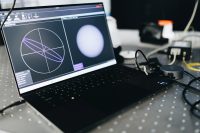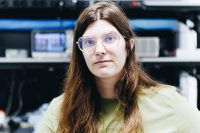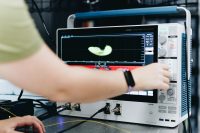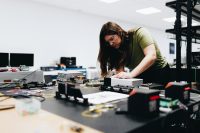The VQCC has developed a simple, self-evaluating, and low-cost quantum random number generator
True random number generation is crucial for achieving tamper-proof cryptographic solutions, among other applications. True randomness can only be achieved by devices that operate under the laws of quantum mechanics, which is complicated by the fact that these are still very incipient and therefore imperfect. The Vigo Quantum Communication Center (VQCC) has successfully completed an experiment that lays the groundwork for a simple, self-checking, and efficient quantum random number generator
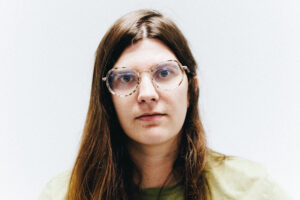
Ana Blázquez
In 1935, Erwin Schrödinger proposed one of the most popular thought experiments inside and outside the scientific community. The protagonist is a cat, which is locked in a sealed box. The cat is not alone but is accompanied by a flask of poison and a device with a radiation-sensitive particle. If the device detects radiation, it will break the flask and release the poison. If it does not detect radiation, the cat will stay alive. We can only know when we open the box and everything will depend on the moment we do it, since there will be a random risk of radiation or not and we cannot know until we look.
In short, the idea is that, while the box is sealed, the cat is dead and alive at the same time because of the quantum uncertainty of the mechanism that could kill it. We cannot know whether it is dead or alive until we open the box and check it.
The Schrödinger’s cat experiment illustrates a phenomenon called quantum superposition, which is based on the fact that a particle can be in multiple states at the same time until it is measured –that is until it is observed–, an intervention that causes the fixation of a particular state. Technically, it is said that at that moment the superposition collapses to a definite state. In the case of the cat, it means the difference between life and death and is totally unpredictable.
The key concept is randomness. And achieving a system that generates real randomness is only possible by applying the laws of quantum mechanics. This is the premise on which the Quantum Communications Technologies Group of the Vigo Quantum Communication Center (VQCC) is working in its development of a simple, self-checking, and cost-effective quantum random number generator (QRNG).
What are random numbers for? The applications are manifold but range from something as prosaic as gambling machines –to ensure that their operation is really governed by chance– to something as strategic as communications security –to ensure tamper-proof message encryption–.
Going back to the metaphor of the cat, we can imagine that every time we open the box we are generating a random number. If the cat is alive, the number is 1, and if it is dead, the number is 0. But until we open the box –or measure the quantum system–, we have no way of knowing what number we will get. In short, quantum random numbers depend on measuring indeterminate quantum states.
Truly unpredictable
 So for something to be truly random, it has to be unpredictable, like the state of Schrödinger’s cat. “A random number generator produces a series of numbers without any pattern, so the numbers cannot be predicted,” explains Ana Blázquez, a researcher at the VQCC. These kind of numbers are already being tried to be generated today with classical supercomputers. And we say they try because the nature of these devices is determined precisely by the fact that they always work following a pattern. In the case of number generation, identifying such a pattern makes it possible to predict the result, so that, even with the most sophisticated methods, classical computers only manage to produce what are called pseudorandom numbers. It can be very complex to decipher the pattern but it is not impossible.
So for something to be truly random, it has to be unpredictable, like the state of Schrödinger’s cat. “A random number generator produces a series of numbers without any pattern, so the numbers cannot be predicted,” explains Ana Blázquez, a researcher at the VQCC. These kind of numbers are already being tried to be generated today with classical supercomputers. And we say they try because the nature of these devices is determined precisely by the fact that they always work following a pattern. In the case of number generation, identifying such a pattern makes it possible to predict the result, so that, even with the most sophisticated methods, classical computers only manage to produce what are called pseudorandom numbers. It can be very complex to decipher the pattern but it is not impossible.
The method being developed at VQCC not only achieves true randomness thanks to the inherently indeterministic nature of quantum physics but it is also low-cost. “Quantum technology usually comes at a very high price, so reducing the cost makes it more accessible,” explains Blázquez. Undoubtedly, this is a crucial aspect so that, for example, cryptographic solutions based on this technology are within the reach of more entities and individuals to protect their communications from hackers.
In addition, the generator proposed by Vigo’s team is self-evaluating, which means that it can verify by itself and in real time whether it is producing truly random numbers. “A current difficulty in QRNGs is proving that the randomness you are generating really comes from quantum physics and not, for example, from a list of numbers that an intruder has put at the end of your experiment and that he or she knows beforehand,” the researcher explains. “Our system is self-evaluating through real-time monitoring that certifies that the device is working in a quantum way and is therefore secure.”
This relates to another key feature of the system: it functions effectively even if the devices are not perfect or fully reliable, which is the case with current quantum computers still in their early stages of development. As a result, the system devised by the VQCC can be implemented more quickly, as it is already compatible with existing hardware, accelerating its practical applicability.
This implies that companies handling sensitive data, government agencies, banks, and individuals with high security needs could adopt this solution in the near future. “The experiment is now complete, and we are currently in the process of writing a paper on the results obtained,” Blázquez explains.
Laser pulses and vacuum
The experiment has involved collaboration between the University of Vigo –through the VQCC, the School of Telecommunications Engineering, and the AtlanTTic research center– and the University of Geneva (Switzerland).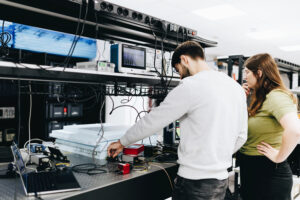
Of all the known methods for generating quantum states –and, therefore, capable of supporting the production of truly random numbers– the ones selected for the experiment are laser pulses and vacuum. In the first case, the laser is activated for a brief moment, generating a pulse that, once emitted, is attenuated until the average number of photons per pulse is less than one. When isolated, a photon behaves probabilistically according to the laws of quantum mechanics, which is the intended outcome. “Optical fiber is the medium we use to propagate the signal in the experiment. We chose it because it is highly developed due to its use in telecommunications. Producing quantum states and transmitting them as light through this medium is practical, requiring no cryogenization, and we avoid working with potentially harmful radiation,” Blázquez explains.
In the case of a vacuum, “the laser doesn’t emit anything; it is turned off. What we do is measure the fluctuations of the electromagnetic field itself, which are produced by the uncertainty principle. Even the vacuum is a quantum state, and it takes on unpredictable values when measured,” explains the VQCC researcher.
While finalizing the scientific paper in which they will publish their results, the team continues to refine and optimize these findings. “For instance, we are enhancing how polarization is maintained in the system by using a special type of fiber, better controlling the stabilization of temperature during the experiment, switching to a laser that allows for more frequent pulse emissions, and even integrating the system into a photonic chip,” says Blázquez.
The quantum future
Ana Blázquez is clear about the urgent need to address the strategic interest of quantum technologies today so that they become a constructive tool in the future, rather than a threat. “At this moment, there is a growing interest in developing the new computational paradigm represented by quantum computers. The field of cryptographic security cannot overlook the potential for a world where a device capable of breaking the foundation of all current cybersecurity becomes commonplace,” she explains.
In her opinion, although quantum key distribution provides unconditional security, it is currently a very expensive option “that only a few can afford and which also has certain limitations, such as the distance over which it can function effectively.” The VQCC researcher is confident that in the future if quantum computers continue to evolve at a steady pace, this technology will become essential for secure communication.
In the meantime, quantum random number generators (QRNGs) face fewer implementation challenges, primarily because they don’t require distributing quantum states over long distances. “Despite this, they still have a higher cost compared to other random number generation systems, so I believe it’s crucial to continue research to reduce costs and address the current limitations,” she says, referring to both QRNGs and quantum key distribution technologies.


